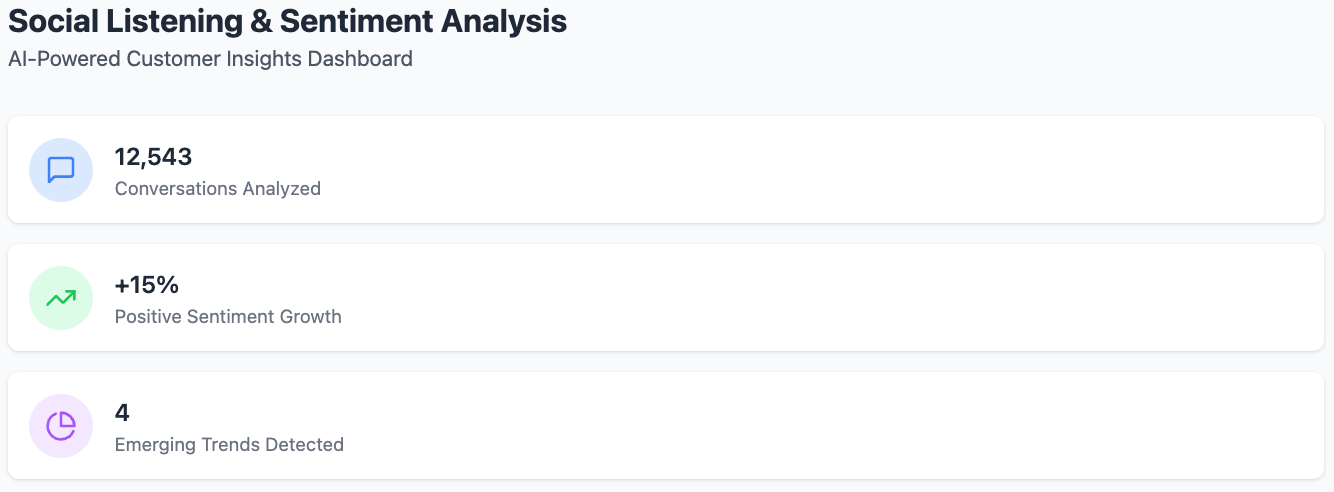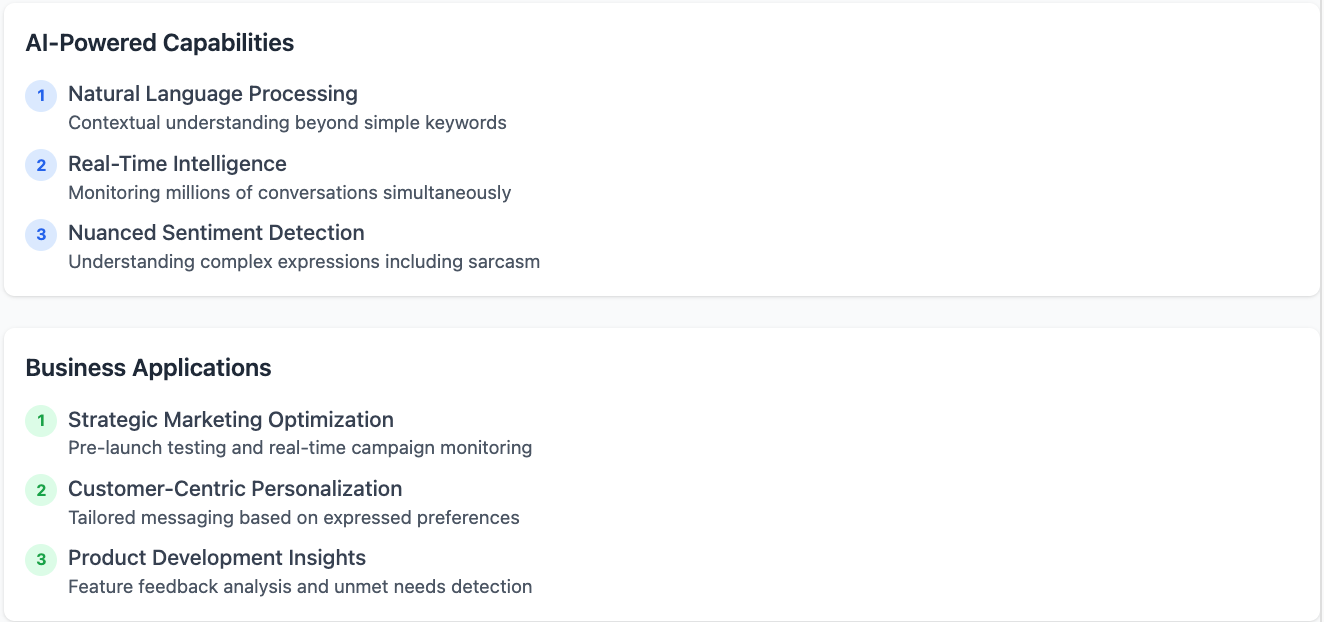The Power of Social Listening and Sentiment Analysis with AI
The Power of Social Listening and Sentiment Analysis with AI: Transforming Business Intelligence and Revolutionizing Customer Insights
In today’s digital landscape, customers are constantly sharing their opinions, experiences, and customer feedback across social media platforms, review sites, forums, and other online channels. This wealth of unstructured data contains invaluable insights that can guide business decisions—if only organizations could effectively capture and interpret it all. This is where artificial intelligence has become a game-changer, transforming social listening and sentiment analysis from labor-intensive tasks into powerful, real-time business intelligence tools.

The Evolution of Social Listening
Traditional social listening relied heavily on manual monitoring and basic keyword tracking of social media channels, which limited both scale and depth of analysis. Monitoring social media conversations has become crucial in the evolution of social listening, enabling businesses to gain insights into public sentiment and consumer interests. Today’s AI-powered solutions represent a quantum leap forward, offering capabilities that were previously impossible:
-
Comprehensive coverage across platforms, languages, and media types
-
Contextual understanding that considers the full meaning behind messages
-
Nuanced sentiment detection beyond simple positive/negative classification
-
Pattern recognition that identifies emerging topics before they become mainstream trends
This evolution has transformed social listening from a reactive reporting function into a proactive strategic tool that drives decision-making across marketing, product development, customer service, and beyond.
From Manual to AI-Powered
The evolution of social listening has transformed the way businesses interact with their customers. Traditional social listening involved manual tracking of brand mentions and relevant keywords across various platforms. However, this approach was time-consuming, labor-intensive, and often lacked depth, missing out on context, sentiment nuances, and emerging trends. With the advent of AI-powered social listening, businesses can now analyze vast amounts of data in real-time, gaining deeper insights into customer behavior, preferences, and opinions.
AI-powered social listening tools can search millions of posts quickly, understand language nuances, and identify trends and patterns in online conversations. This enables businesses to respond more effectively to customer needs, maintain a competitive edge, and make data-driven decisions. The integration of AI into social listening has revolutionized the way businesses understand and engage with their customers, providing a more efficient, accurate, and scalable approach to social media management.

Limitations of Traditional Social Listening
Traditional social listening has several limitations that make it less effective in today’s fast-paced digital landscape. One of the primary limitations is the inability to analyze vast amounts of data in real-time. Manual tracking of brand mentions and relevant keywords can be time-consuming and labor-intensive, often resulting in delayed responses to customer inquiries and concerns.
Another limitation of traditional social listening is the lack of depth and context. Manual analysis can miss out on subtle nuances of language, including sarcasm, irony, and sentiment. This can lead to inaccurate insights and poor decision-making. Furthermore, traditional social listening often relies on keyword tracking, which can be limited in its ability to capture the complexity of online conversations.
In contrast, AI-powered social listening tools can analyze vast amounts of data in real-time, providing deeper insights into customer behavior, preferences, and opinions. AI-powered tools can also understand language nuances, identify trends and patterns, and provide predictive analytics, enabling businesses to make data-driven decisions and maintain a competitive edge.

The Power of AI in Social Listening and Sentiment Analysis
Real-Time Intelligence at Scale
Perhaps the most transformative aspect of AI-powered social listening is its ability to process and analyze massive volumes of data in real time. Modern AI systems can:
-
Monitor millions of conversations simultaneously across multiple platforms
-
Identify sentiment shifts as they happen, not days or weeks later
-
Alert brands to emerging issues before they become full-blown crises
-
Track campaign performance from the moment content goes live
This real-time capability allows businesses to understand the current state of customer sentiment and quickly adapt their strategies accordingly. For example, a brand can immediately assess audience reaction to a new marketing campaign and make adjustments if the response isn’t as positive as expected.
Beyond Keywords: Contextual Understanding with Natural Language Processing
Early sentiment analysis tools relied on simplistic keyword matching—counting positive and negative words to determine sentiment. Modern AI approaches are exponentially more sophisticated:
-
Natural Language Processing (NLP) analyzes the grammatical structure and meaning of text
-
Entity recognition identifies specific products, people, and features being discussed
-
Contextual analysis understands phrases within their broader context
-
Sarcasm and idiom detection recognizes when literal meanings don’t apply
This contextual understanding enables businesses to capture the true sentiment behind customer communications, even when those feelings are expressed in complex or nuanced ways. Incorporating predictive insights into strategic planning can significantly enhance customer engagement strategies by understanding historical trends to inform marketing campaigns, product developments, and overall customer relations.
Improved Accuracy Through Machine Learning
AI sentiment analysis continues to improve through machine learning, with each analysis making future interpretations more accurate:
-
Models train on industry-specific language and terminology
-
Algorithms learn to recognize emerging slang and expressions
-
Systems adapt to evolving language patterns over time
-
Feedback loops incorporate human corrections to improve future accuracy
This continuous learning process means that AI sentiment analysis becomes increasingly precise as it processes more data, particularly within specific industry contexts.
Transformative Applications for Modern Businesses
Strategic Marketing Optimization
AI-powered sentiment analysis offers marketers unprecedented insights for campaign development and optimization:
-
Pre-launch testing gauges initial reactions to concepts and messaging
-
Real-time campaign monitoring enables immediate adjustments based on audience response
-
Competitor analysis reveals gaps and opportunities in the market
-
Influencer identification finds authentic voices that resonate with target audiences
These capabilities allow marketing teams to develop more effective campaigns, optimize messaging in real-time, and demonstrate clearer ROI for their initiatives.
Customer-Centric Personalization
Understanding customer sentiment at an individual and segment level enables truly personalized experiences:
-
Customized messaging that resonates with specific audience segments
-
Tailored content recommendations based on expressed interests and preferences
-
Personalized offers aligned with customer sentiment and previous interactions
-
Adaptive customer journeys that evolve based on changing sentiment
This deep understanding of customer feelings and preferences allows brands to craft experiences that feel remarkably relevant and timely.
Holistic Brand Perception Monitoring
AI sentiment analysis provides a comprehensive view of brand perception across the digital ecosystem:
-
Multi-channel monitoring tracks sentiment across social media, news, reviews, and forums
-
Unified dashboard consolidates sentiment data from disparate sources
-
Sentiment trending shows how brand perception changes over time
-
Competitive benchmarking compares sentiment against industry peers
AI-powered tools can also help manage negative sentiments by promptly identifying and addressing them, thereby improving customer service and overall brand perception.
This holistic view enables organizations to understand not just what customers are saying about their brand, but how those perceptions compare to competitors and how they evolve over time.
Product Development and Innovation
Customer sentiment contains valuable insights that can guide product development priorities:
-
Feature feedback analysis identifies the most praised and criticized product elements
-
Unmet needs detection uncovers opportunities for new products or features
-
Competitive feature comparison highlights areas where products lag behind alternatives
-
Early problem detection catches potential issues before they affect larger customer bases
By incorporating this sentiment data into the product development process, companies can create offerings that better address customer needs and preferences.
Competitor Analysis and Market Research
Competitor analysis and market research are critical components of business strategy. AI-powered social listening tools can provide valuable insights into competitor activity, industry trends, and market sentiment. By analyzing online conversations, businesses can gain a deeper understanding of their competitors’ strengths and weaknesses, as well as emerging trends and opportunities.
AI-powered social listening tools can also provide insights into customer preferences, opinions, and behaviors. This enables businesses to refine their marketing strategies, improve customer support, and identify emerging trends and opportunities. Furthermore, AI-powered tools can provide predictive analytics, enabling businesses to anticipate potential problems and make data-driven decisions.
Implementation Challenges and Best Practices
While AI-powered social listening offers tremendous benefits, successful implementation requires addressing several challenges:
Data Quality and Filtering
The sheer volume of social data creates significant filtering challenges:
-
Spam detection removes automated or irrelevant content
-
Bot identification distinguishes between genuine user sentiment and artificial activity
-
Duplicate elimination prevents the same content from being counted multiple times
-
Relevance scoring prioritizes the most significant conversations
Effective filtering ensures that sentiment analysis is based on genuine, relevant customer expressions rather than noise.
Contextual Limitations
Even advanced AI has limitations in understanding certain aspects of human communication:
-
Cultural nuances that vary across regions and demographics
-
Visual content interpretation including memes, images, and videos
-
Platform-specific communication styles that evolve rapidly
-
Sarcasm and humor that can be difficult for AI to detect consistently
Organizations can address these limitations by combining AI analysis with human oversight, particularly for high-stakes decisions.
Data Access Restrictions
Social platforms increasingly limit data access for privacy and competitive reasons:
-
API limitations restrict the volume and type of data available
-
Privacy regulations affect what data can be collected and analyzed
-
Walled garden approaches by major platforms reduce visibility
-
Changing terms of service create uncertainty about future data access
Successful organizations develop diversified listening strategies that incorporate multiple data sources rather than relying on a single platform.
Future Trends in AI-Powered Social Listening
As AI technology continues to evolve, several emerging trends will shape the future of social listening and sentiment analysis:
Multimodal Analysis
Next-generation tools will analyze multiple types of media simultaneously:
-
Image and video analysis to detect sentiment in visual content
-
Audio sentiment detection for podcasts, videos, and voice messages
-
Emoji and reaction interpretation as meaningful sentiment indicators
-
Cross-format sentiment correlation to understand multi-channel expressions
This multimodal approach will provide a more complete picture of customer sentiment across all forms of expression.
Predictive Sentiment Analysis
AI will increasingly move from descriptive to predictive sentiment analysis:
-
Trend forecasting to anticipate how conversations will evolve
-
Crisis prediction to identify potential issues before they escalate
-
Opportunity detection to spot emerging positive sentiment early
-
Impact modeling to predict how actions will affect customer sentiment
These predictive capabilities will enable truly proactive management of customer perceptions and experiences.
Democratized Access Through Simplified Tools
Advanced sentiment analysis capabilities are becoming more accessible:
-
No-code interfaces that make analysis available to non-technical users
-
Automatic insight generation that surfaces key findings without manual analysis
-
Natural language queries that allow users to ask questions about sentiment data
-
Embedded analytics that incorporate sentiment insights into existing workflows
Tools like Sprout’s AI-powered features with Theme suggestions and Summarize by AI Assist exemplify this trend toward more accessible and actionable sentiment analysis.
Conclusion: The Competitive Advantage of AI-Powered Customer Understanding
As AI-powered social listening and sentiment analysis continue to evolve, they will become increasingly central to business strategy. Organizations that effectively leverage these technologies gain a significant competitive advantage through:
-
Deeper understanding of customer needs and preferences
-
More agile marketing and product development
-
Proactive management of brand perception
-
Enhanced ability to identify and capitalize on emerging trends
In a world where customer expectations are constantly evolving, AI-powered social listening provides the real-time insights needed to stay relevant and responsive. The organizations that master these capabilities won’t just understand their customers better—they’ll be able to anticipate and shape customer experiences in ways that drive sustainable business growth.
This article explores how artificial intelligence is transforming social listening and sentiment analysis, providing businesses with real-time insights, improved accuracy, increased efficiency, and trend detection capabilities that drive more effective marketing strategies and customer experiences.
